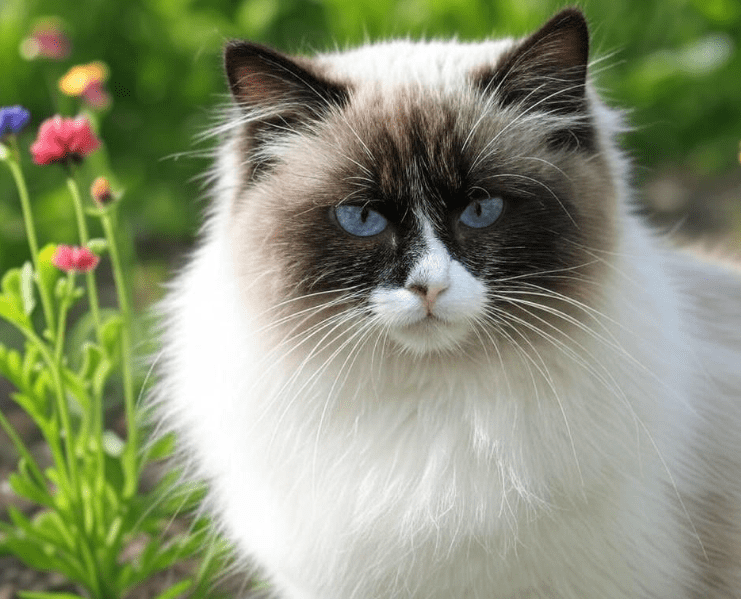
Bringing a new pet into a home with a Ragdoll cat can be an exciting yet delicate process. Known for their docile and affectionate nature, a Ragdoll cat’s temperament makes them generally adaptable to new companions. However, their calm demeanor doesn’t guarantee a seamless introduction. Without careful planning, stress and conflict can arise. This guide provides a comprehensive, step-by-step approach to introducing your Ragdoll cat to a new pet—whether it’s another cat, a dog, or a smaller animal—ensuring a peaceful transition for everyone involved.
By understanding your Ragdoll’s personality, preparing thoughtfully, and following proven strategies, you can foster a harmonious multi-pet household. This article covers everything from initial preparations to long-term relationship building, offering practical tips and expert insights to make the process drama-free.
Understanding the Ragdoll Cat’s Personality
Ragdolls are a unique breed, often described as “puppy-like” due to their friendly, laid-back, and sociable nature. These traits can make introducing a Ragdoll cat to a new pet easier compared to more territorial breeds. However, every Ragdoll is an individual, and their reaction to a new pet will depend on factors like age, past experiences, and socialization.
Key Traits of Ragdolls
Affectionate and Social: Ragdolls typically enjoy companionship, whether human or animal, making them more open to new pets.
Calm and Non-Aggressive: They’re less likely to react with hostility, but they may become stressed if introductions are rushed.
Sensitive to Change: Ragdolls thrive on routine, so sudden changes can cause anxiety.
Playful but Gentle: Their playful side can help them bond with other pets, especially if the new pet is energetic but not overly dominant.
Understanding these traits is crucial for tailoring the introduction process to your Ragdoll’s needs. For example, their sensitivity to change means you’ll need to introduce the new pet gradually to avoid overwhelming them.
Preparing for the Introduction
Proper preparation sets the stage for a successful introduction. Before bringing the new pet home, take these steps to ensure your Ragdoll cat and the new arrival are ready to meet.
1. Assess Your Ragdoll’s Readiness
Observe your Ragdoll’s behavior and history:
Socialization: Has your cat interacted with other animals before? A well-socialized Ragdoll is more likely to accept a new pet.

Health: Ensure your cat is healthy, as stress from a new pet can exacerbate medical issues. Schedule a vet checkup if needed.
Temperament: If your Ragdoll is shy or anxious, you’ll need to proceed more slowly.
2. Choose the Right New Pet
Not all pets are a good match for a Ragdoll. Consider the following:
Energy Levels: Ragdolls are moderately active, so a hyperactive pet might overwhelm them, while a calm pet may be a better fit.
Size and Breed: For example, a large, boisterous dog may intimidate a Ragdoll, while a smaller, gentle dog could be ideal.
Age: Puppies and kittens are often easier to introduce, as they’re less likely to assert dominance.
3. Create a Safe Environment
Set up your home to reduce stress during the introduction:
Separate Spaces: Designate a “safe room” for the new pet with food, water, a litter box (for cats), and bedding. This gives them a space to adjust without immediate contact.
Ragdoll’s Territory: Ensure your Ragdoll has access to their favorite spots, like their bed or scratching post, to maintain a sense of security.
Neutral Zones: Identify areas where neither pet has strong territorial claims for initial meetings.
4. Gather Supplies
Stock up on essentials to make the transition smoother:
Pheromone Diffusers: Products like Feliway for cats or Adaptil for dogs can reduce stress.
Extra Litter Boxes: For cat-to-cat introductions, provide one litter box per cat, plus one extra.
Toys and Treats: Use these to create positive associations during interactions.
Baby Gates or Barriers: These allow visual contact without physical access, ideal for early introductions.
5. Health Precautions
Vet Checks: Ensure both pets are up-to-date on vaccinations and free of parasites.
Quarantine: Keep the new pet in a separate area for 7–14 days to monitor for signs of illness, especially if introducing another cat.
Step-by-Step Guide to Introducing a Ragdoll Cat to a New Pet
The introduction process should be gradual, allowing both animals to adjust at their own pace. Follow these steps to minimize stress and encourage a positive relationship.

Step 1: Scent Introduction (Days 1–3)
Before any face-to-face meeting, familiarize the pets with each other’s scents:
Scent Swapping: Rub a cloth on the new pet and place it near your Ragdoll’s bed or feeding area, and vice versa. Reward your Ragdoll with treats for calm behavior near the scent.
Shared Items: Swap bedding or toys between the pets to build familiarity.
Observe Reactions: If your Ragdoll hisses or avoids the scent, slow down and give them more time.
Step 2: Controlled Visual Contact (Days 4–7)
Once both pets are comfortable with each other’s scents, allow them to see each other without physical interaction:
Use Barriers: Place a baby gate or screen door between the pets. For example, keep the new pet in their safe room and let your Ragdoll approach the door.
Short Sessions: Start with 5–10 minute sessions, gradually increasing the duration.
Positive Reinforcement: Reward both pets with treats or praise for calm behavior during these encounters.
Monitor Body Language: Look for signs of stress in your Ragdoll, such as flattened ears, dilated pupils, or a tucked tail. If these occur, reduce session length.
Step 3: Supervised Physical Meetings (Week 2)
When both pets seem relaxed during visual contact, allow them to meet in a controlled setting:
Neutral Territory: Choose a neutral area where neither pet feels territorial.
Leash or Crate: For dog introductions, keep the dog on a leash. For small animals like rabbits, use a secure crate.
Short and Sweet: Keep initial meetings brief (5–10 minutes) and end on a positive note.
Distraction Tools: Engage both pets with toys or treats to prevent fixation on each other.
Step 4: Gradual Integration (Weeks 3–4)
As the pets grow more comfortable, increase their time together:
Supervised Free Time: Allow both pets to interact without barriers, but stay present to intervene if needed.
Shared Activities: Encourage bonding through playtime or feeding (in separate bowls, placed at a distance).
Monitor Dynamics: Ensure neither pet is bullying or overly submissive. Ragdolls are gentle, so watch for signs they’re being overwhelmed.
Step 5: Full Integration (Month 2 and Beyond)
Once the pets coexist peacefully, you can allow unsupervised interactions:
Gradual Freedom: Start with short unsupervised periods and monitor their behavior when you return.
Maintain Routines: Keep your Ragdoll’s feeding, play, and cuddle times consistent to avoid jealousy.
Separate Resources: Provide separate food bowls, litter boxes, and resting areas to prevent competition.
Tailoring the Process to Different Pets
The introduction process varies depending on the type of pet you’re bringing home. Here’s how to adjust for common scenarios:
Introducing a Ragdoll Cat to Another Cat
Territorial Concerns: Cats are naturally territorial, so scent swapping and gradual introductions are critical.
Litter Box Etiquette: Provide one litter box per cat, plus one extra, to avoid conflicts.
Play Styles: Ensure both cats have compatible energy levels. Ragdolls are moderately playful, so a highly dominant or aggressive cat may not be a good match.
Introducing a Ragdoll Cat to a Dog
Dog Temperament: Choose a dog with a calm, cat-friendly demeanor. Breeds with high prey drives may pose a risk.
Training: Ensure the dog responds to basic commands like “sit” and “stay” to prevent chasing.
Supervised Interactions: Keep the dog on a leash during early meetings and reward calm behavior.
Introducing a Ragdoll Cat to a Small Animal (e.g., Rabbit, Guinea Pig)
Safety First: Ragdolls have a mild hunting instinct, but supervision is essential to protect smaller animals.
Secure Enclosures: Use sturdy cages or enclosures for the small animal, and never allow unsupervised access.
Desensitization: Gradually expose your Ragdoll to the small animal’s scent and presence to reduce curiosity.
Common Challenges and Solutions
Even with careful planning, challenges may arise. Here’s how to address them:
1. Aggression or Fear from the Ragdoll
Solution: Slow the process down. Return to scent swapping or visual contact and extend the timeline. Use pheromone diffusers to reduce anxiety.

Expert Tip: Consult a feline behaviorist if aggression persists beyond a few weeks.
2. Jealousy or Attention-Seeking
Solution: Spend one-on-one time with your Ragdoll to reassure them. Maintain their routine and avoid favoring the new pet.
Example: If your Ragdoll loves evening cuddles, ensure this time remains sacred.
3. Resource Guarding
Solution: Provide separate resources (food, water, litter boxes) to prevent competition. Gradually move feeding stations closer as the pets grow comfortable.
Pro Tip: Place resources in different areas of the house to reduce territorial disputes.
4. Stress-Related Behaviors
Signs: Hiding, reduced appetite, or excessive grooming in your Ragdoll.
Solution: Create a quiet retreat for your cat, use calming supplements (consult your vet), and avoid forcing interactions.
Long-Term Strategies for a Harmonious Multi-Pet Household
Once the initial introduction is complete, focus on building a lasting bond between your Ragdoll and the new pet:
Regular Playtime: Engage both pets in group activities like chasing a feather wand or playing fetch.
Positive Reinforcement: Continue rewarding calm and friendly interactions with treats or praise.
Monitor Health: Stress can lead to health issues like urinary problems in cats. Watch for changes in behavior or litter box habits.
Grooming and Bonding: For cat-to-cat introductions, mutual grooming is a sign of acceptance. Encourage this by brushing both cats together.
Adapt to Changes: As pets age or new circumstances arise (e.g., moving homes), be prepared to revisit introduction strategies.
Expert Tips for Success
To elevate your approach, consider these insights from veterinarians and pet behaviorists:
Start Young: Kittens and puppies are more adaptable, so introducing a young pet to a Ragdoll often yields faster results.
Use Technology: Pet cameras can help you monitor interactions when you’re not home, ensuring safety during early unsupervised periods.
Consult Professionals: If you’re unsure about the process, a certified animal behaviorist can provide personalized guidance.
Patience is Key: Every pet pair is unique. Some Ragdolls may bond within weeks, while others take months to fully accept a new companion.
Conclusion

Introducing a Ragdoll cat to a new pet doesn’t have to be stressful. By leveraging the Ragdoll’s friendly and adaptable nature, preparing thoroughly, and following a gradual introduction process, you can create a peaceful multi-pet household. The key is patience, observation, and a commitment to meeting both pets’ needs. With the strategies outlined in this guide, you’ll be well-equipped to foster a lasting bond between your Ragdoll and their new companion, ensuring a drama-free transition and years of happy coexistence.




